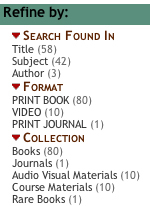 One of the great functions of a library is to provide space for information discovery. However, as information searching transitioned from a paper-based endeavor into a predominantly electronic activity. the likelihood of unexpectedly discovering resources took a severe downturn. For instance, the library OPAC has simplified the search process, but in so doing the time spent browsing the stacks has been significantly reduced. This reduction limits the likelihood of unexpected discovery. Thankfully the recent trend in online catalogs towards faceted search interfaces has begun to address this problem.
One of the great functions of a library is to provide space for information discovery. However, as information searching transitioned from a paper-based endeavor into a predominantly electronic activity. the likelihood of unexpectedly discovering resources took a severe downturn. For instance, the library OPAC has simplified the search process, but in so doing the time spent browsing the stacks has been significantly reduced. This reduction limits the likelihood of unexpected discovery. Thankfully the recent trend in online catalogs towards faceted search interfaces has begun to address this problem.
Faceted searching provides users more opportunity for virtually browsing the collection. Search results are accompanied with links for faceted navigation, presenting users with a variety of facets (format, date, author, subject, location, etc.) by which they can refine their search results. Encore is one of several faceted search interfaces currently on the market. However, unlike its competitors (at least those that I am aware of), it offers two added features that I just love – social tagging and tag clouds!

With Encore, once a patron has signed into their account, they are allowed to create and link tags with item records. Fields from bibliographic entries can also be imported as tags. Patron and library created tags are treated equally and displayed as one, thus encouraging a hitherto nonexistent collaborative relationship between library staff and users. However, Catalogers have no need to fear – these tags appear together, but they are stored separately. Therefore, Encore allows libraries to take advantage of Web 2.0 technologies, while preserving catalog records within their bibliographic databases.
 One way in which this technology could be used in an academic library would be to use tags to direct students to materials relevant to particular courses. By creating a course tag such as ART100 students, faculty, and library staff can tag resources relating to themes covered in the class. The resulting tag clouds provide users with a second option for virtual browsing. One that is increasingly familiar to the student clientele of academic libraries. By offering tools such as Encore, libraries can reestablish themselves as spaces (both virtual and physical) for information discovery.
One way in which this technology could be used in an academic library would be to use tags to direct students to materials relevant to particular courses. By creating a course tag such as ART100 students, faculty, and library staff can tag resources relating to themes covered in the class. The resulting tag clouds provide users with a second option for virtual browsing. One that is increasingly familiar to the student clientele of academic libraries. By offering tools such as Encore, libraries can reestablish themselves as spaces (both virtual and physical) for information discovery.
A product of Innovative Interfaces, the creators of Millennium, Encore is compatible with a number of its ILS competitors, such as Voyager and ALEPH 500.
Filed under: Uncategorized | Tagged: Encore, faceted searching, library catalog, LinkedIn, social tagging, tag clouds |


I have not seen Encore, so I don’t know its full capabilities, but I know of at least 2 ways to get social tagging and tag clouds into a library catalog. Penn tags was developed by for the University of PA library several years ago and does pretty much what you describe. Library Thing also provides a service where their user reviews and tags can be added to a library catalog. This has the advantage of “pre-loading” tons of user generated tags for books in the catalog, but looses the idea of tagging something for a specific course. Also, I believe that the Library Things tags are clearly separated from subject headings in the catalog. I am not sure whether that is a good thing or a bad one.
Thanks, Carrie! We’re really excited about Encore too and having a blast bringing librarians & patrons together in new ways.
Michael, I’d say the critical difference between the Encore approach and those taken in other tools involving tagging & library collections is that they require the user to add the tags in another, non-integrated interface. The users of that other interface also may not actually represent the community for this library and the collection development decisions made for it.
I have an article in the December issue of American Libraries which touches on this as well as giving lots of examples of how libraries are using community tagging in Encore.